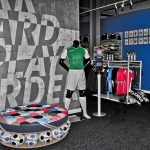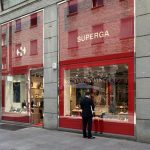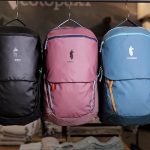On its second-quarter analyst call, Tim Boyle, Columbia Sportswear’s chairman, CEO and president, warned that U.S. wholesale orders for the flagship Columbia brand would likely remain down at least through the first half of 2026 as efforts to revive demand for the brand are being undermined by conservative orders from retailers in the face of proposed tariffs.
The weakness at the Columbia brand in the U.S., as well as the impact of tariffs, prompted Columbia to provide a weak outlook for the current year despite second-quarter earnings arriving slightly above plan as strong international momentum offset the soft sales in the U.S.
Shares of Columbia early Friday are trading down about 12 percent.
For the current fiscal year, Columbia’s forecast now calls for sales of $3.3 billion to $3.4 billion, representing a decline of 1 percent or gain of 1 percent year-over-year. That’s down from Columbia’s forecast given in February calling for sales in the range of $3.40 to $3.47 billion, representing growth of 1.0 to 3.0 percent compared to 2024.
The company pulled its annual outlook when it released first-quarter results in May due to uncertainties caused by the proposed tariffs and its current guidance remains “limited” with a focus solely on the top line.
Tariff Concerns Leading to Cautious Ordering
Boyle said the reduced outlook reflects lower assumptions for its U.S. wholesale and DTC businesses, partially offset by higher forecasts in most international markets.
He said Columbia is planning its U.S. business “cautiously” in the second half in large part due the potential impact of tariffs. He said, “We expect higher prices for many consumer goods will negatively impact consumer demand. We also expect retailers will be cautious with their inventory intakes in this uncertain environment.”
The company is further planning to take much of the tariff hit and limit pricing actions. Boyle said, “In fall ’25, we’re working with our retail partners to deliver value to consumers and keep inventory and dealer margins healthy. As a result, we’re not making any significant price changes to our fall ’25 product line and expect to absorb much of the incremental tariff costs this year.”
He said Columbia estimates the financial impact of the current 10 percent universal tariff rate, combined with tariff-related supply chain expenses and inclusive of mitigation efforts, will be approximately $35 million to $40 million in 2025.
With moves to bring in product early, Boyle noted that by August 1 Columbia will have received approximately 70 percent of its U.S. fall ’25 product. The remaining 30 percent will face higher tariff rates beyond the initial 10 percent universal tariff rate and it’s unknown what the impact will be on its U.S. business.
Boyle said Columbia is exploring numerous options for offset the impact of higher U.S. tariffs, including price increases, vendor negotiations, SG&A expense efficiencies, including layoffs taken during the quarter that primarily impacted its U.S. corporate headcount. Year-to-date, Columbia has actioned over $70 million in annual cost savings on top of the $90 million actioned in 2024.
For the third quarter, sales are expected to decline 1 percent to 3 percent year-over-year and diluted EPS to be in the range of $1 to $1.20, down from $1.56 a year ago. The outlook assumes tariffs on U.S. imports remain at the additional 10 percent universal rate for all countries, except for China, which remains at 30 percent for the remainder of the year. Boyle added, “Any additional tariffs beyond these rates would further increase cost of sales and reduce operating profit.”
Cautious Ordering Extending to Spring 2026
Looking further ahead, Boyle that that to date, Columbia has received almost 90 percent of its projected spring ’26 orders with the initial spring order book, taken together with its in- season forecast, supporting an outlook for flat to low single-digit percent wholesale growth in the first half of ’26.
This forecast for the first half of next year contemplates growth for all of its emerging brands, led by Mountain Hardwear and Sorel. For the Colombia brand, international orders reflect sustained growth momentum across direct and distributor markets, but tariff uncertainty and soft business trends are weighing on initial orders in the U.S. Said Boyle, “This fall, they’re taking a conservative approach to placing orders for future seasons. As a result, we expect Colombia’s U.S. wholesale business to remain down in the first half of ’26.”
Boyle expressed confidence that the flagship brand’s ACCELERATE growth initiative that includes the launch of a new global marketing platform in coming days will help “energize Columbia’s brand perception in the U.S. and bring new customers to the brand.”
Other parts of the ACCELERATE growth program include better leveraging digital and social-first strategies, enhancement to product assortments including the new Amaze Puff Insulated Jacket and redesigned Rock Band, and elevated in-store investments at both its own and wholesale partner doors.
Boyle nonetheless cautioned, “Elevating consumers’ perception of the Columbia brand and ultimately restoring healthy U.S. growth will take time. Our new product collections, new brand voice and marketplace investments are just starting to take hold this fall and will build momentum into 2026.”
Q2 Results Beat Plan
In the second quarter, sales increased 6 percent (6 percent constant-currency) to $605.2 million, exceeding Columbia forecast calling for sales in the range of $575 to $600 million. Analysts’ consensus target had been $589.5 million.
The 6 percent revenue gain primarily reflects changes in wholesale shipment timing which benefited sales in the quarter, and higher Spring 2025 wholesale orders, partially offset by lower direct-to-consumer (DTC) net sales. Sales growth in most of its international markets was offset by underlying weakness in the U.S.
By channel, wholesale sales jumped 14 percent (14 percent currency-neutral) to $317.2 million. DTC sales eased 1 percent (2 percent currency-neutral) to $288.0 million.
The net loss in Columbia’s smallest-volume quarter was reduced slightly to $10.2 million, or 19 cents per share, compared to a loss of $11.7 million, or 20 cents, a year ago. Columbia didn’t provide EPS guidance for the quarter. Results topped analysts’ consensus estimate calling for a loss of 28 cents.
Gross margins expanded 120 basis points to 49.1 percent, reflecting healthier less clearance and promotional activity, as well as favorable product sales mix, partially offset by unfavorable channel and region sales mix. SG&A expenses were 53.8 percent of sales, up from 53.1 percent a year ago. Columbia’s operating loss decreased to $23.6 million from $23.8 million a year ago.
Regional Performance in Q2
By region, sales were down 2 percent in the United States to $335.1 million,
“Overall, U.S. Columbia brand spring ’25 sell-through has been soft,” said Boyle. “These outdoor categories and consumer headwinds reinforce our focus on reenergizing the Columbia brand through the ACCELERATE growth strategy.”
The U.S. wholesale business increased low single-digit percent, reflecting timing of spring and fall wholesale shipments, which benefited sales in the quarter. U.S. DTC sales declined mid-single-digit percent. Brick-and-mortar was down low single-digit percent, reflecting the closure of temporary clearance locations, partially offset by contributions from new stores. Columbia in the U.S. exited the quarter with seven temporary clearance locations compared to 46 exiting second quarter last year. E-commerce was down low double-digit percent, reflecting soft spring season sell-through, which was partially impacted by ongoing efforts to refine and evolve its online promotions and marketing investments.
In the Latin America and Asia Pacific region, sales rose 13 percent (12 percent currency-neutral) to $112.3 million. On a currency-neutral basis, China’s sales increased high teens with broad-based growth across wholesale and DTC. Said Boyle, “Our team in China continues to do an amazing job bringing young active consumers into the brand with premium localized product offerings and unique marketplace activations.” He further said its e-commerce business in China across Tmall, JD and TikTok “remains a vital component of our growth strategy in China.” On a currency-neutral basis, Japan increased mid-single digits and Korea was up low-single digits.
Sales in the in Europe, Middle East and Africa region jumped 26 percent (24 percent currency-neutral) to $130.6 million. Europe direct net sales increased high teens percent with growth across all channels, led by DTC stores. The EMEA distributor business climbed high 20s percent driven by a healthy order book and early shipment of fall ’25 orders. Said Boyle, “Europe is sustaining its brand momentum through grassroots brand activations in the important height category as well as elevating online and in-store marketing across wholesale and DTC.”
In Canada, sales nudged up 2 percent (5 percent currency-neutral) to $27.2 million with wholesale growth more than offsetting a decline in DTC.
Brand Performance in Q2
By brand, Columbia’s sales were up 8 percent (7 percent currency-neutral) in the second quarter to $548.3 million. Boyle said the brand’s product focus emphasized differentiated sun protection and cooling technologies and reenergized PFG styles. He said, “Our product teams continue to focus on creating products and driving growth with our targeted consumers who value innovation and style.”
Innovations include the Insect Shield technology to support insect repellency. In footwear, the new Omni-MAX Konos Featherweight is performing well in the marketplace and receiving positive accolades.
During the second quarter, the Columbia North America regional organization was realigned to bring together its wholesale and direct-to-consumer businesses. Peter Rauch, who most recently oversaw Columbia’s Asian direct business, will step into the role of general manager for the Columbia brand in North America. Boyle said, “This new structure will sharpen our focus and improve our ability to seize growth opportunities in our largest region.”
Among its emerging brands, Sorel’s sales fell 10 percent (11 percent currency-neutral) to $18.8 million. The decline was primarily driven by lower spring ’25 orders and lower DTC clearance activity compared to elevated PFAS product clearance in the prior year. Boyle said sell-through for Sorel’s spring product line, including sneakers and sandals, has been healthy and suggests the brand is stabilizing. He said, “I believe momentum will continue to build for Sorel in the seasons ahead. This fall, new products and brand imagery will further energize Sorel and retailers are responding positively to the Spring ’26 collection. I’m confident Sorel is moving in the right direction.”
Prana’s sales were down 6 percent (6 percent currency-neutral) to $20.5 million, primarily reflecting soft e-commerce performance in part due to lower clearance activity compared to prior year levels. Said Boyle, “Prana’s brand refresh will build momentum this fall with new product collections and refreshed brand imagery. The Prana team is developing a clear voice and omnichannel growth strategy. I’m excited to see it come to life in the seasons ahead.”
Mountain Hardwear’s sales were off 7 percent (7 percent currency-neutral) to $17.5 million with full price growth more than offset by lower clearance activity compared to PFAS product clearance in the prior year, resulting in a significantly higher margin. Said Boyle, “As we move into fall, Mountain Hardwear will be activating new snow sports and cold weather trail marketing campaigns that embody their distinctive voice and imagery. During this period of tariff disruption, I believe Mountain Hardwear has the opportunity to further strengthen its position in the outdoor specialty channel. Spring ’26 orders indicate healthy wholesale growth in the first half of next year.”
Image courtesy Columbia Sportswear

